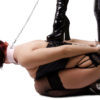Kink
Various roles in Ageplay
There is a certain catharsis that arises from the act of age-playing. While age-play is not inherently related to BDSM, the catharsis felt from it is not unlike the catharsis described by dominants and submissives in the BDSM community after a “play session”. Not only is age-play itself not a direct cause of negative feelings, it can also act as a form of therapy. It generally requires a very calm and tranquil atmosphere, and can also incorporate the participation of individuals that you care for and trust immensely. Age-playing allows one to show their most vulnerable side to another human being who is under a silent, understood oath to value that vulnerability rather than abuse it. Age-playing is about unconditional love, nurturing, patience, extreme kindness, and simplicity. These aspects are most easily achieved through (in general terms) a “Little/Caregiver dynamic”.
Part I on How my interest in Ageplay came about
Part II on The difference between Ageplay and Pedophilia
“Little” can be used as a blanket term that describes any individual age-playing as younger than their biological age, or it can be used as a more specific term to describe one classification of age-player. Some of the major categories under this term are “AB/DLs”, “Littles” (as a specific classification), and “Middles”. While there are no hard-and-fast rules and guidelines as to what exactly constitutes each of these terms, there do exist a few large, sweeping themes generally present in each category.
Broadly speaking, an “AB/DL” (adult baby/diaper lover) in relation to age-play is an adult who role-plays as a toddler or infant. On the surface, this appears to simply be the use of infant and toddler paraphernalia by adults (diapers, bottles, bibs, pacifiers, adult-sized infant clothing). In actuality, the core of AB/DL style age-play is more dependent on the activities and intentions involved. For most individuals, the attraction to this style of age-play is the amount of tender love, care, and attention it requires. When one is role-playing as someone who would be completely dependent on a caregiver, there is a tremendous amount of trust involved. To participate in this activity and have that trust honored, as well as to be cared for in such an intense and pure fashion, is incredibly rewarding to the parties involved.
A “Little” in relation to age-play is an adult who role-plays as being older than diaper-wearing ages, yet younger than teenage years. The lines between AB/DLs and Littles, as well as the lines between Littles and Middles are quite easily blurred because a Little, in simple terms, role-plays somewhere in between AB/DL and Middle styles of age-play. Littles generally do not use infant or toddler paraphernalia, although the use of these items by a Little is not unheard of. Typically, Littles gravitate more toward older activities and clothing styles, such as grade school associated clothing, dolls, higher level coloring books, stuffed animals, dress up, action figures, toy cars and trucks, etc. Being a Little generally involves a slightly more verbally sophisticated level of communication with the caregiver and provides for more boundary testing. Littles are usually more independent than AB/DLs while role-playing, and this can in some cases provide a situation that involves even more patience on the part of the caregiver.
“Middles” are adults who role-play as teenagers. Some activities enjoyed by your average Middle include going to parties and concerts, skateboarding, going to the mall, listening to music, reading, writing, and creating art. Middles typically still play with toys whilst age-playing, but rather than dolls or pacifiers, these are generally older toys such as suction-cup dart guns, paint-ball guns, skateboards, etc. There is often an increased interest in electronic devices such as laptops, MP3 players, tablets, cell phones, and digital cameras. Some Middles cite craving structure while still enjoying their freedom as being their reason for enjoying this particular role.
The term “Caregiver” or “Big” is granted to those who play roles that are traditionally given to adult role-models and authority figures. Some examples of these roles might be as specific as teachers, parents, aunts and uncles, grandparents, babysitters, or nannies, or as general as “designated adult”. Littles and Caregivers do not always define their dynamic with specific titles. Caregivers sometimes create rules for the Littles designed to help the Littles achieve their dreams and goals, grow as a person, and gain life-perspective and confidence. These rules may be as simple as telling a Little not to jump on the couch to teach them respect for personal property and patience, or as specific and fine-tuned as instructing a Little who is an aspiring writer to write at least one paragraph each day as practice, or even telling a Little with body-image issues that they are to say ten things they like about themselves in the mirror each night before bed to boost their self-confidence. Rules can be enforced through various methods, but by far the most popular is spanking. Other examples of repercussions for breaking the rules might be time out, being denied dessert, having a favorite toy taken away, or canceled trips to fun places.
Caregivers are not only there to punish. They are also there to reinforce good behavior by rewarding their Little. Rewards range from physical affection (hugs, kisses, piggy-back rides, massages, etc.) and small gifts (crayons, accessories, foil stars, stickers), to large gifts and trips. Caregivers help to build a Little’s confidence, teach them not to base their self-worth on others’ opinions, teach responsibility, respect, independence, and personal accountability, as well as provide them with a safe place to vent their frustrations and the knowledge that they have someone they can trust fully and rely on in any situation.
In return for this special love, care, and attention, the Little makes the Caregiver feel appreciated, helpful, and loved as well. Many Caregivers want to feel needed and have a long-lasting, positive effect on the lives of those they care about. Age-play gives them a paradigm in which that can be accomplished and properly appreciated. Caregivers fulfill Littles by providing a sense of security, stability, and unconditional love, while Littles fulfill caregivers by helping them to appreciate the small things in life, making them feel instrumental in the positive growth of another individual, and providing them with unconditional love and trust. Put simply, Little/Caregiver dynamics are symbiotic relationships that provide for a deeper emotional satisfaction than could otherwise be achieved by these individuals through a more generic relationship..
The final part on What I like about Ageplay is next!
Images courtesy of Shutterstock
Have an amazing experience or tips you like to share on SimplySxy? Drop us an email at editorial@SimplySxy.com!
I'm Dolly, and I'm a super petite 4' 9" adult performer from Oregon. I own and operate my own erotica website featuring all my best work called DollysPlayhouse.Com! In my spare time, I'm making organic, eco-friendly soaps, candles, makeup, and other bath and body products from scratch as well as doing my best to educate the public about my favorite kink- ageplay!





























